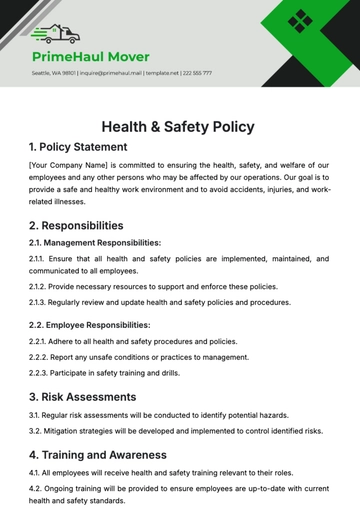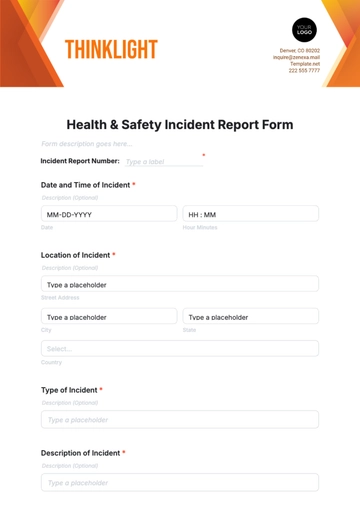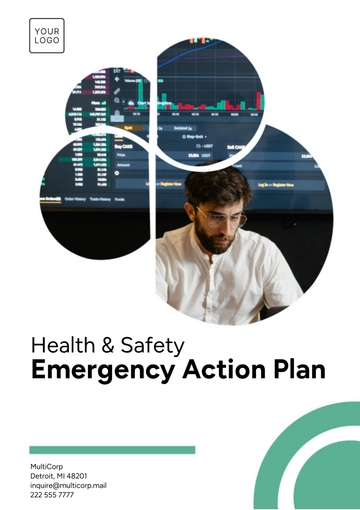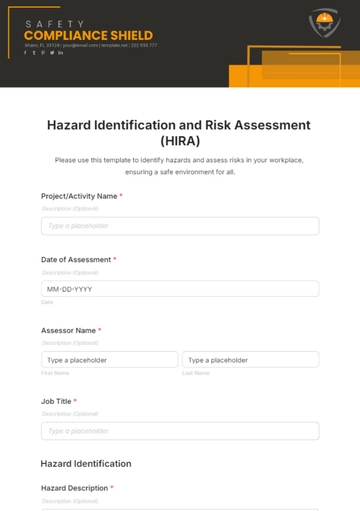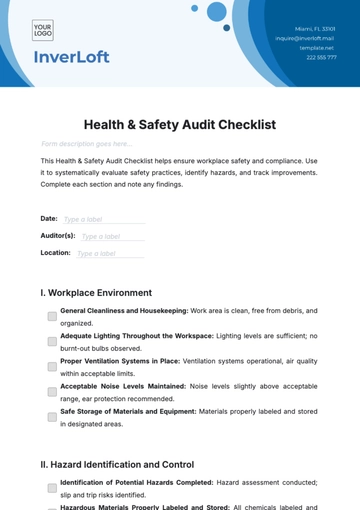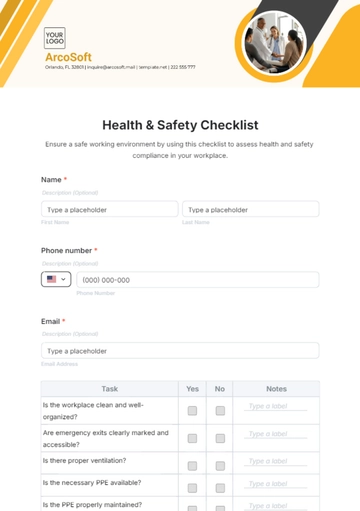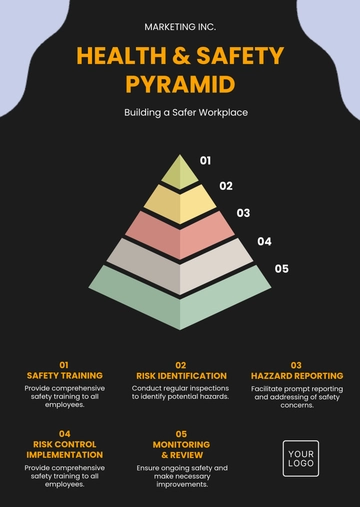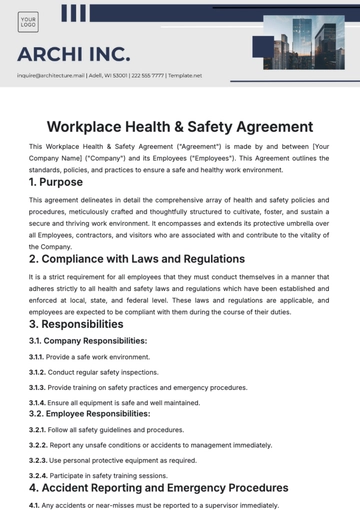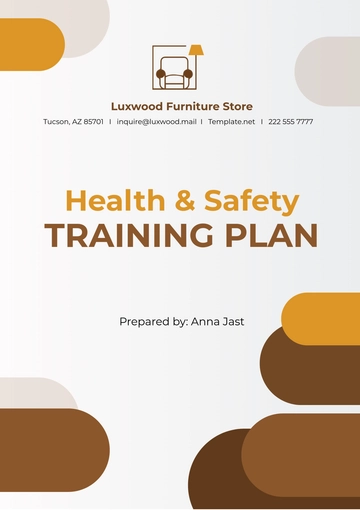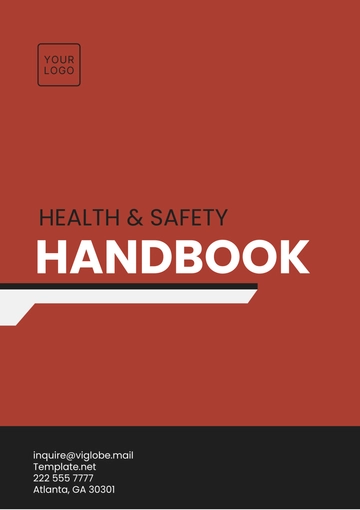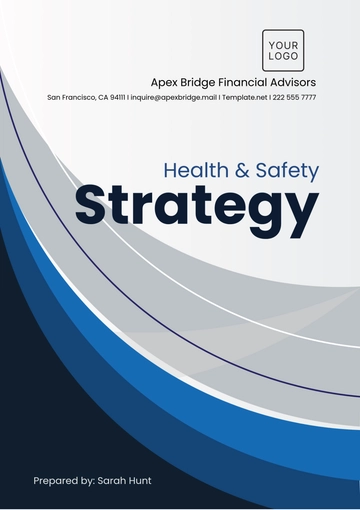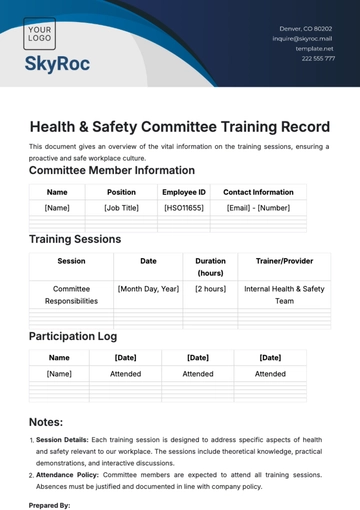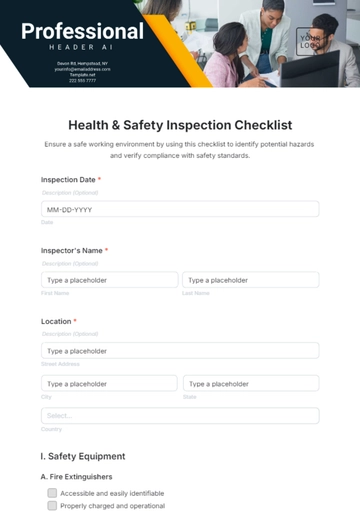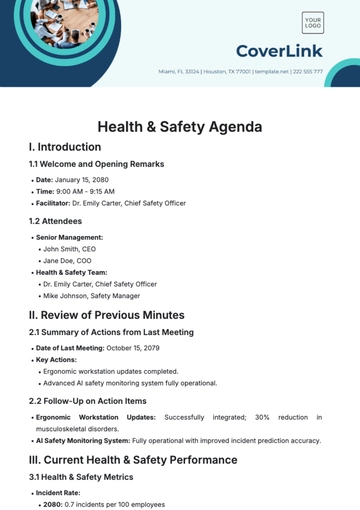Free Health & Safety Awareness Impact Study
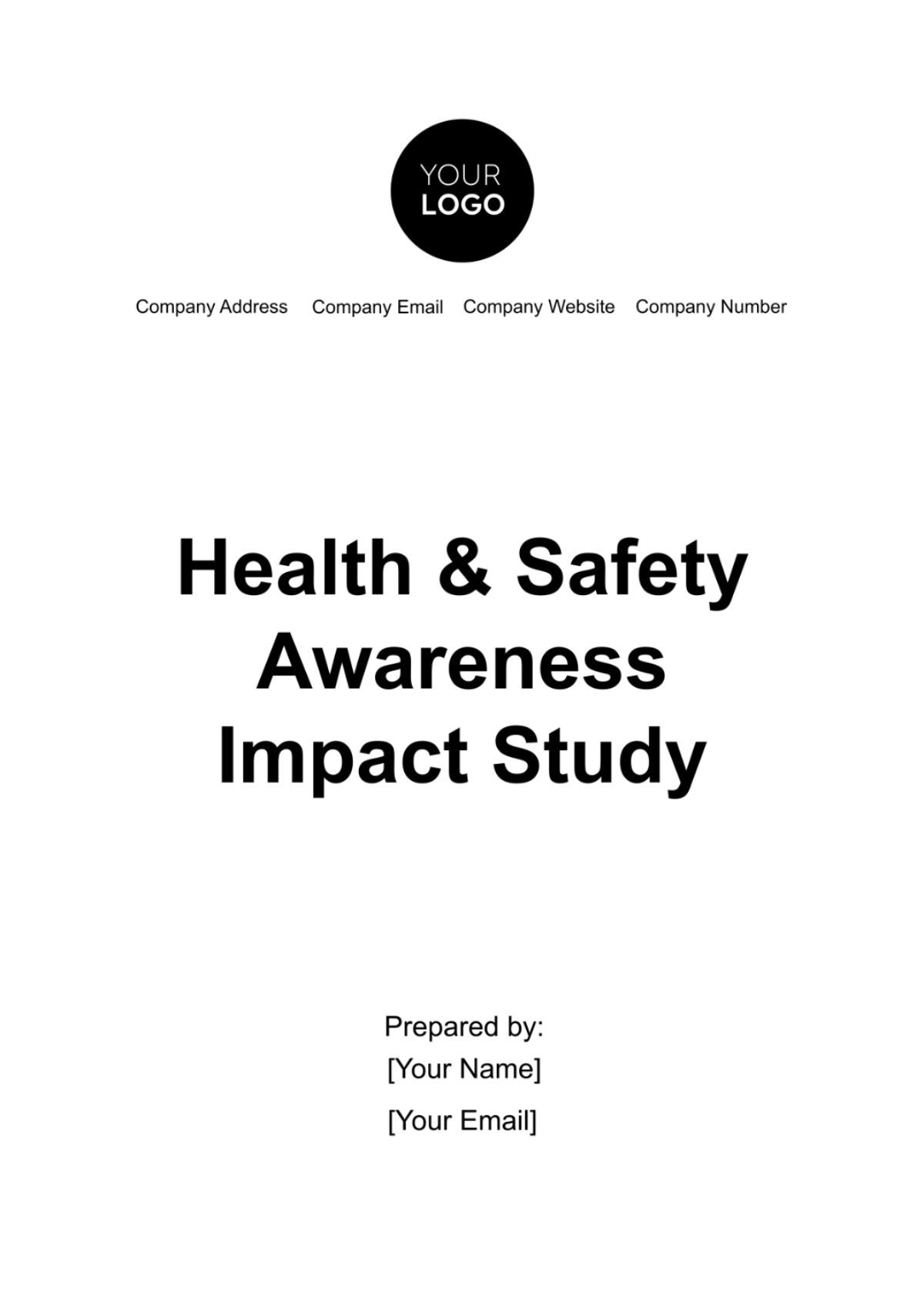
Executive Summary
This Health & Safety Awareness Impact Study provides an in-depth analysis of the effectiveness of health and safety awareness initiatives implemented in our organization. The study was conducted with the objective of evaluating the impact of these initiatives on reducing workplace incidents, enhancing employee awareness and engagement, and fostering a culture of safety.
Objectives
The primary objectives of the study were to:
Assess the reduction in workplace incidents post-implementation of safety initiatives.
Gauge employee perceptions and attitudes towards health and safety.
Evaluate the effectiveness of training programs and communication campaigns.
Key Findings
Significant Reduction in Workplace Incidents: The data revealed a notable reduction in workplace incidents, with a 37.5% decrease in 2081 and a 47.9% decrease in 2082 compared to previous years.
Improved Employee Awareness and Attitudes: Employee feedback showed a substantial increase in safety awareness and confidence in emergency preparedness. Positive responses regarding safety procedures improved by 20%, and overall perception of workplace safety increased by 20%.
High Engagement in Training Programs: Participation and completion rates for safety training programs saw a significant rise, indicating heightened employee engagement and commitment to workplace safety.
Recommendations
Based on the study’s findings, the following recommendations are made to further enhance our health and safety efforts:
Enhance incident reporting mechanisms for greater transparency and feedback.
Develop targeted and specialized training programs.
Introduce interactive methods in training and awareness campaigns.
Implement regular safety protocol refreshers.
Expand ergonomic assessments and include mental health elements in safety initiatives.
Introduction
This Health & Safety Awareness Impact Study is a comprehensive evaluation aimed at assessing the effectiveness of our current health and safety awareness initiatives. Through this study, we seek to understand the impact these initiatives have had on our workforce and overall workplace safety culture.
Purpose of the Study
The primary objective of this study is to systematically analyze the outcomes and effectiveness of our health and safety awareness programs. By evaluating these initiatives, we aim to identify their strengths, uncover areas for improvement, and ultimately enhance their overall impact on our organization’s health and safety. This study will guide us in making informed decisions about future health and safety strategies and investments.
Background on Existing Initiatives
Our organization has implemented a series of health and safety awareness initiatives over the past years. These initiatives encompass a wide range of activities and programs, including:
Regular Safety Training Workshops: Focused sessions conducted periodically to educate employees on various workplace safety topics.
Health and Safety Communication Campaigns: A series of campaigns using posters, emails, and intranet articles to raise awareness about specific health and safety issues.
Emergency Drills and Exercises: Regularly scheduled drills to ensure preparedness for various emergency scenarios.
Health and Safety Surveys: Surveys distributed to employees to gather feedback on their perception of workplace safety and the effectiveness of our safety programs.
Ergonomic Assessments: Regular assessments conducted to ensure workstations are ergonomically designed to reduce the risk of strain injuries.
Methodology
In order to accurately assess the effectiveness of our health and safety awareness initiatives, a multi-faceted approach was employed. This methodology combines quantitative and qualitative data gathered through surveys, interviews, and an analysis of workplace safety records.
Employee Surveys: Distributed to all employees, these surveys aimed to gauge their awareness and perceptions of health and safety practices, and the effectiveness of current initiatives.
One-on-One Interviews: Conducted with a diverse group of employees across various departments, these interviews provided in-depth insights into the personal impact and perceived effectiveness of the health and safety initiatives.
Data Analysis: Review of workplace safety records pre and post-implementation of the initiatives to identify any quantitative changes in safety-related incidents.
Focus Groups: Organized with representatives from different employee sectors to discuss and gather feedback on the health and safety programs, and to brainstorm potential improvements.
Initiatives Overview
The table below provides an overview of the key health and safety awareness initiatives that have been implemented, along with their objectives and intended outcomes.
Initiative | Objectives | Intended Outcomes |
Regular Safety Training Workshops | To educate employees on workplace safety topics | Enhanced knowledge and application of safety practices |
Health and Safety Communication Campaigns | To increase awareness of specific safety issues | Improved safety culture and reduced risk of incidents |
Emergency Drills and Exercises | To ensure preparedness for various emergencies | Quick and effective response in emergency situations |
Impact Evaluation
The evaluation of the impact of our health and safety awareness initiatives is critical to understand their effectiveness and guide future improvements. This section details the assessment methods used to gauge the effectiveness of these initiatives, focusing on key indicators such as incident reduction, employee feedback, and compliance rates.
Assessment
Incident Reduction Analysis: Comparison of workplace incident and accident records before and after the implementation of the initiatives to identify any significant changes in frequency or severity.
Employee Feedback Analysis: Analysis of responses from health and safety surveys and interviews, focusing on employee perceptions of safety awareness and changes in attitude or behavior.
Training Participation and Completion Rates: Evaluation of employee participation and completion rates in safety training workshops, as well as the effectiveness of training as reflected in post-training assessments.
Emergency Drill Performance: Assessment of employee performance during emergency drills, measuring the level of preparedness and response effectiveness.
Compliance Rate Assessment: Review of compliance rates with established health and safety protocols, particularly in high-risk areas of the organization.
Ergonomic Assessment Outcomes: Analysis of the results from ergonomic assessments, including the number of ergonomic interventions implemented and their impact on employee comfort and injury rates.
Methods
Statistical Analysis: Use of statistical tools to analyze data from incident reports, survey responses, and training records for a quantitative understanding of the impact.
Qualitative Assessment: Interpretation of qualitative data from interviews, focus groups, and open-ended survey responses to gain insights into the subjective effectiveness of the initiatives.
Benchmarking: Comparing our health and safety performance metrics with industry standards or benchmarks to gauge our relative standing and areas for improvement.
Longitudinal Study: Monitoring changes over an extended period to understand the long-term impact of the initiatives on health and safety culture.
Findings
Table 1: Incident Reduction Analysis
Time Period | Number of Incidents (Pre-Initiative) | Number of Incidents (Post-Initiative) | Percentage Reduction |
2080 | 48 | - | - |
2081 | - | 30 | 37.5% |
2082 | - | 25 | 47.9% |
Figure 1: Employee Feedback Analysis
Figure 2: Training Participation and Completion Rates
Discussion
The findings from our study reveal significant insights into the effectiveness of our initiatives. These results provide a compelling narrative about how our efforts in promoting health and safety awareness have positively influenced the workplace environment.
Incident Reduction Analysis: The notable decrease in workplace incidents, with a reduction of 37.5% in 2081 and 47.9% in 2082, is a clear indicator of the effectiveness of our safety initiatives. This significant decline suggests that the implementation of these programs has successfully mitigated risks and enhanced safety practices among employees.
Employee Feedback Analysis: The improvement in positive responses regarding awareness of safety procedures (20% increase), confidence in emergency preparedness (22% increase), and the overall perception of workplace safety (20% increase) demonstrates a substantial shift in employee attitudes towards health and safety. This shift is indicative of a more informed and safety-conscious workforce, a critical component in fostering a proactive safety culture.
Training Participation and Completion Rates: The increase in participation and completion rates for key training programs underscores the growing commitment of our employees to health and safety. The jump in participation rates for General Workplace Safety (from 75% to 95%), Fire Safety and Evacuation (from 70% to 92%), and Ergonomics and Workstation Setup (from 65% to 88%) suggests that our training programs are both engaging and perceived as valuable by the workforce.
Alignment with Objectives
The results of the study align closely with the primary objectives of our health and safety awareness initiatives, which were to reduce workplace incidents, enhance employee awareness and knowledge of safety practices, and foster a culture of safety across the organization. The data not only reflects a reduction in safety incidents but also a marked improvement in employee engagement and attitudes towards health and safety. This suggests a successful integration of safety principles into the daily practices and mindset of our employees.
Recommendations and Conclusion
Based on the findings and discussion of the Health & Safety Awareness Impact Study, the following recommendations are proposed to further enhance our health and safety initiatives:
Strengthening Incident Reporting Mechanisms: Despite the reduction in incidents, further improvements can be made by enhancing the ease and anonymity of reporting mechanisms to encourage even more reporting and feedback.
Targeted Training Programs: Develop more specialized training programs focused on areas where incidents still occur, using the data from the incident reduction analysis to guide content development.
Enhanced Engagement Strategies: Implement more interactive and engaging methods in training and awareness campaigns, such as gamification or rewards for active participation, to maintain high engagement levels.
Regular Refreshers on Safety Protocols: Introduce regular refresher courses or briefings to ensure that safety protocols remain fresh in employees’ minds and adapt to any new safety standards or practices.
Expansion of Ergonomic Assessments: Given the positive reception and effectiveness, expand the scope of ergonomic assessments to more departments and include regular follow-ups.
Continued Focus on Mental Health and Well-being: Incorporate more elements related to mental health and overall well-being into the health and safety initiatives, recognizing their impact on workplace safety.
Conclusion
The Health & Safety Awareness Impact Study has demonstrated a substantial positive impact of our health and safety initiatives on reducing workplace incidents, enhancing employee safety awareness, and fostering a proactive safety culture. The marked improvement in employee engagement in safety training and their growing awareness and understanding of safety practices are testaments to the success of these initiatives.
However, it is imperative to recognize that the journey towards optimal workplace health and safety is ongoing. The importance of continuous improvement cannot be overstated; it is crucial to regularly assess, refine, and enhance our health and safety strategies to adapt to new challenges and ensure the well-being of all employees. By embracing these recommendations and remaining committed to continuous improvement, we can build upon our successes and maintain our dedication to a safe, healthy, and productive work environment.
- 100% Customizable, free editor
- Access 1 Million+ Templates, photo’s & graphics
- Download or share as a template
- Click and replace photos, graphics, text, backgrounds
- Resize, crop, AI write & more
- Access advanced editor
Introducing Template.net's Health & Safety Awareness Impact Study Template, an essential tool for assessing the effectiveness of safety awareness initiatives. Fully customizable and editable in our Ai Editor Tool, this template enables businesses to measure the impact of their health and safety programs. Streamline the evaluation process and optimize safety practices with our user-friendly platform.

